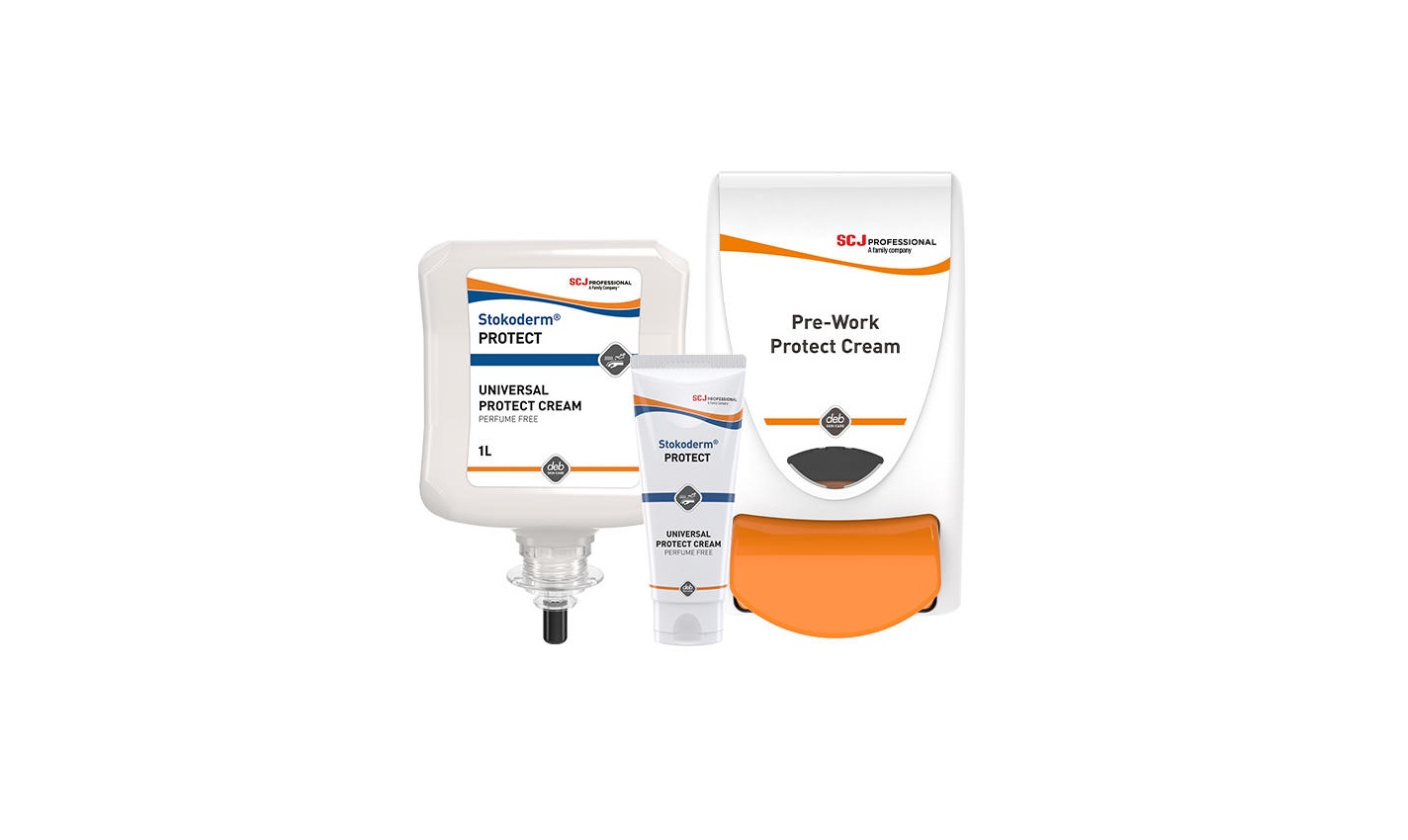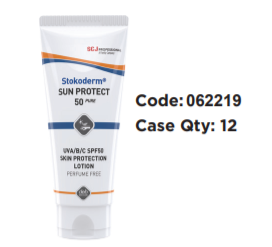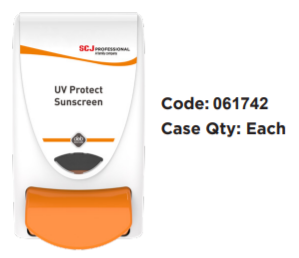SCJohnson Stokoderm 50+ Sun Protection UVA, UVB and UVC rays Instruction Manual
WHAT IS UV??
Ultraviolet (UV) radiation is an invisible type of radiation produced by the sun. There are three distinct types: UVA, UVB and UVC rays1.
UVA rays have a longer wavelength, which means they are able to penetrate into deeper layers of the skin – these rays can also causepremature ageing.UVB rays can significantly contribute to the development of skin cancer. These rays have a medium wavelength and can burn the outer layers of the skin.Lastly, whilst UVA and UVB radiation reaches the earth’s surface, shorter wavelength UVC radiation is blocked by the ozone layer.. UVC rays are also damaging and can be created artificially during industrial processes such as welding.

WHAT IS SUNBURN?
Sunburn is a clear sign that the DNA in the skin cells has been damaged by too much UV radiation from the sun.You can’t feel this UV radiation – the heat from the sun actually comes from infrared rays. This is why people can still burn on cool days.Getting painful sunburn, just once every 2 years, can triple your risk of melanoma skin cancer .
WHO IS AT RISK?
OUTDOOR WORKERS
OUTDOOR WORKERS HAVE A HIGHER THAN AVERAGE RISK OF DEVELOPING SKIN CANCER7
Each episode of sunburn increases the risk of getting skin cancer8. In order to stay protected as much as possible, an averagesized adult should apply at least six full teaspoons to cover the body, which equates to more than half a teaspoon on each arm and the face/neck including ears.
VEHICLE DRIVERS
A PERSON SITTING IN A VEHICLE CAN BE AT RISK OF SIGNIFICANT EXPOSURE TO HARMFUL UV RAYS9
There are many different types of glass; each provides varying levels of sun protection. Most glass used for windows only provides moderate protection10, effectively blocking UVB, but not UVA rays9, which means that drivers and pilots could be at risk of over exposure to UV11. When UV levels are 3 and above, it is recommended that thosewho spend long periods of time in a vehicle use sun protection10.
WELDERS
UV WELDING ARCS AND FLAMES EMIT INTENSE VISIBLE UV AND INFRARED RADIATION12
UV radiation such as that found in a welding arc can burn unprotected skin, just as UV radiation from sunlight can damage the skin. This is true for direct exposure to UV radiation as well as reflections from metal surfaces, walls and ceilings12. UV protection cream can be applied to help enhance protection, but should not be used as a replacement to proper PPE.
BEST PRACTICE
FOLLOW THE 5 S APPROACH WHEN WORKING OUTSIDE13. OVER-EXPOSURE TO THE SUN IS A SERIOUS HEALTH THREAT AND SHOULD BE AVOIDED.

DUTY OF CARE
LEGAL OBLIGATION
EMPLOYERS HAVE A DUTY OF CARE TO PROTECT THEIR EMPLOYEES FROM HAZARDS IN THE WORKPLACE. ACCORDING TO HSE GUIDELINES, UV RADIATION SHOULD BE CONSIDERED AN OCCUPATIONAL HAZARD FOR THOSE WHO WORK OUTDOORS14.
The Health and Safety at Work Act makes it clear that there is a legal duty on every employer to ensure, as far as reasonably practical, the health of their employees. It also states that employers must provide ‘information, instruction, training and supervision’ to ensure their safety15. The Management of Health and Work Regulations also requires the employer to conduct a suitable assessment of the risks to the health of their workforce, including those from UV radiation15.
UV INDEX
Adopted by the World Health Organisation, the UV Index indicates the UV levels on a daily basis and advises when sun protection measures are required16.
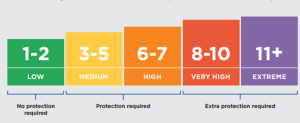
When the UV index reaches 3 or above, sun protection measures should be taken17.
SPF50 RANGE
According to the Health & Safety Executive (HSE), each company has a legal obligation to provide the necessary tools in order to protect= their workforce18. Implementing a ‘Skin Care Protection Programme’ will help your staff understand the importance of skin protection.
SPF50 – WE RECOMMEND USING THE HIGHEST FACTOR SUN PROTECTION CREAM AVAILABLE
- Apply 20 minutes before sun exposure.
- On the average-sized adult, a minimum of 35ml should be applied (equivalent of 1 teaspoon of sunscreen) to each arm, leg, front of body, back of body, and face (including neck and ears).
- Re-apply every 2-3 hours for continuous protection, especially after physical exertion or perspiration.
- Always wear protective clothing, hats and eyewear when exposed to the sun and avoid prolonged exposure19.
Stokoderm® Sun Protect 50 PURE
UV Skin Protection Cream UVA | UVB | UVC
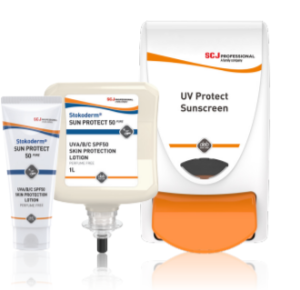
- Broad spectrum sunscreen for professional use with UVB and UVA protection.
- Helps to provide protection against UVC rays artificially created during certain industrial processes, such as arc welding. (Does not replace personal protective equipment).
- Non greasy after feel to encourage regular use and help limit the effect on dexterity with hand held tools.
- Clinically proven to improve skin-hydration.
- Perfume-free, dye-free, water-resistant and silicone-free.
SPF50
Stokoderm® Sun Protect 50 PURE 100ML
- Ideal for workers on the move
- Handy 100ml tube

Stokoderm® Sun Protect 30 PURE 1L Cartridge
- 1000 shots per cartridge
- Hygienic, sealed cartridge to prevent ingress of air

Sun Protect 1L Dispenser.
- Use with Stokoderm® Sun Protect 50 or 30 PURE 1L cartridges

SUN SAFETY CENTRES
Sun Safety Centre
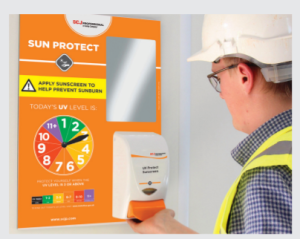
- Encourages workers to apply sun cream
- UV index display
- 1L Sun Dispenser
- Mirror for ease of application
- Use with Stokoderm® Sun Protect 50 or 30 PURE 1L cartridges
DID YOU KNOW…?
ULTRAVIOLET (UV) RAYS…
CHECK YOUR SKIN
Skin cancer can be divided into two main groups: non melanoma skin cancer and malignant melanoma21. Melanoma skin cancer is the fifth most common cancer in the UK and has become much more common over recent years22. Malignant melanoma is curable if treated early, but delay in diagnosis can result in thespread to other sites and organs within the body22.The ABCDE of melanoma rule (below) will help you and your workforce remember what to look out for – the example photographs show abnormal moles and melanomas, but they may vary depending on the individual. If any changes or unusual marks are noticed that have lasted more than a few weeks a doctor should be consulted immediately. A melanoma can grow anywhere on the body so it is important to check the entire body regularly (once per month) for any changes or abnormalities23.
REMEMBER… IF YOU HAVE ANY DOUBT YOU SHOULD CONSULT YOUR DOCTOR23
Read More About This Manual & Download PDF:
References
Melanoma skin cancer
– NHS
Home – PMC – NCBI
Radiation: The ultraviolet (UV) index
We\’re SC Johnson Professional® | SC Johnson Professional
Learn about Solar UV Radiation and skin cancer
Weather and climate change – Met Office
Outdoor work as a risk factor for high-grade cutaneous squamous cell carcinoma of the head and neck
British Association of Dermatologists – Skin Cancer
UV Radiation and the Skin
Causes of cancer and reducing your risk | Cancer Research UK
BCHS | Homepage
What Causes Cancer? | American Cancer Society
Welding – Radiation and the Effects On Eyes and Skin : OSH Answers
About Cancer | Cancer Research UK
Radiation: Ultraviolet (UV) radiation
[xyz-ips snippet=”download-snippet”]

